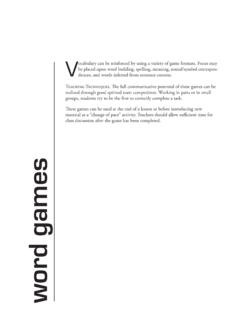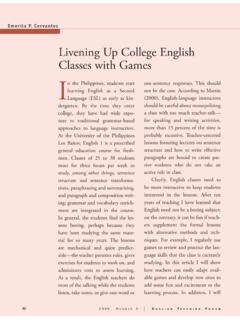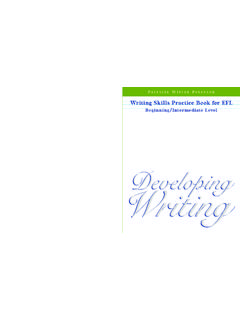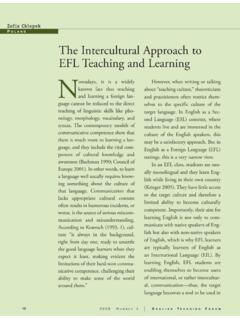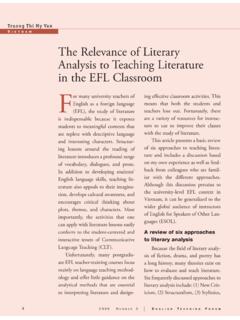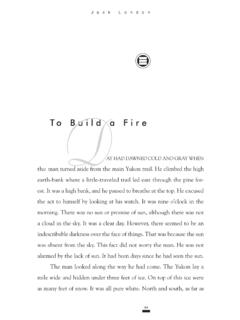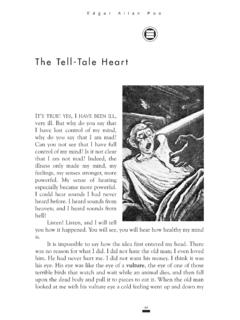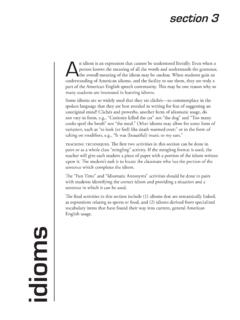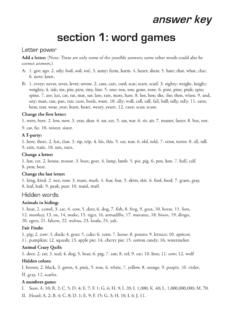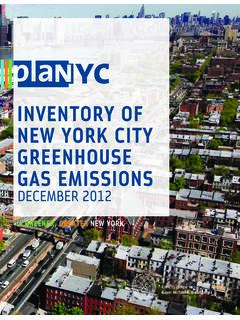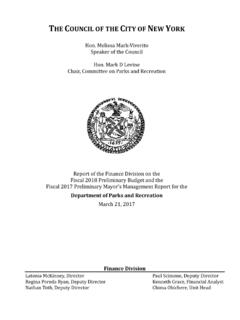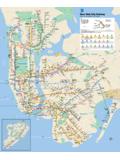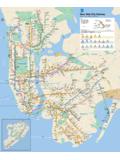Transcription of Bradley Horn Exploring New York City - American …
1 522 0 0 8 Nu m b e r 1 | En g l i s h TEa c h i n g Fo r u m Bradley HornExploring New york CityThe feature article in this issue of English Teaching Forum focuses on one of the most famous cities in the world New york city . This lesson plan is based on that article and the fact sheet about New york that appears at the end of this lesson plan. Every English student in the world probably knows a little about New york city ; the activities in this lesson are designed to give your students the opportunity to gain more detailed information about the city . The lesson is also designed to give students an opportunity to practice an important reading skill: scanning for specific PlanLevel: IntermediateFocus: Reading skills (scanning for specific information), oral presentation skills, writingMaterials: New york city fact sheet (provided); black/whiteboardActivity 1 Warm-up: Creating a city Vocabulary Web (5 10 minutes)To get your students warmed up, you may wish to start with the following activity.
2 In the middle of the board, write the word city and draw a star around it. Tell your students that they will have two or three minutes to brainstorm as many vocabulary words as possible that are related to the topic of cities. You might also want to tell them that, at this point, you are the recorder not their teacher so they shouldn t worry about giving a wrong answer. (During this part of the activity, you should just write every word they say on the board; evaluating their responses will be done in the next stage of the activity.)After your students have brainstormed a number of city words, circle all the vocabulary items you have written on the board. Then ask your students to consider how the words are related. For example, if the students came up with the words taxi, bus, and subway, they might recognize that these are all types of transportation. (You may have to prompt them the first few times, until they figure out what you want them to do.)
3 You would then write the word transportation on the board and draw a square around it. Next, to build the vocabulary web, you would draw lines from each of the circled words (taxi, bus, and subway) to the square (transportation) and from the square to the star ( city ). During this part of the activity, the students can also explain why they called out any words that seem to be unrelated to the topic of cities. If their explanations make sense, you should keep the word on the board and ask the students to consider how it is related to other words. If an explanation does not make sense, then erase the the example above focuses on how words are related semantically, your students may also identify how words are related grammatically by, for example, grouping all of the nouns together, all of the verbs together, etc. This alternative approach is completely acceptable. The important point is that students are recognizing connections among different words.
4 When drawing lines to represent connections between different words, you also shouldn t be surprised if some words are related to many other words. It is also possible that some words will not be related to any other 5212/20/07 11:33:41 AM53En g l i s h TEa c h i n g Fo r u m | Nu m b e r 1 2 0 0 8A completed vocabulary web might look something like this:Activity 2 Prereading: Activating Background Knowledge (5 10 minutes)Before your students read the text, have them complete the prereading quiz (see below). Depending upon how your classroom is arranged, you may wish to photocopy the quiz, write it on the board, or read it aloud for your the students have finished the quiz, do not give them the correct answers right away. Instead, have them find the answers as part of Activity 3 (Scanning for Specific Information). You will check the answers with the class after students have finished the scanning activity.
5 Prereading Quiz: How much do you already know?1. True or false: New york was once the capital city of the United States. a. True b. False 2. What was New york originally called? a. New England b. New Amsterdam c. Verrazano Narrows d. Greenwich Village3. New york city is divided into five boroughs (districts). Which of these is not one of the five boroughs? a. Brooklyn b. The Bronx c. SoHo d. Queens4. Which of the following is a common nickname for New york city ? a. The city of Brotherly Love b. The city of Big Shoulders c. The Big Easy d. The Big Apple5. About how many people live in New york city today? a. 2 million b. 5 million c. 8 million d. 12 millionAIRPLANEBUSBUSSUBWAYDRIVERTRANSPO RTATIONTAXIAIRPORTPEOPLECITYMAYORBUILDIN GSPLACESZOOKEEPERZOONEIGHBORHOODPARK08-2 0001 5312/20/07 11:33:42 AM5420 0 8 Nu m b e r 1 | En g l i s h TEa c h i n g Fo r u mActivity 3 Reading: Scanning for Specific Information (15 20 minutes)Preparation: For the reading activity, you will need at least one copy of the New york city fact sheet for each students read the text, divide the class into small groups (2 4 students).
6 Briefly review the instructions for the scanning activity and make sure they understand the information questions. (Again, these questions can be photocopied, written on the board, or dictated to students.)Reading: Scanning for Specific Information1. How much land does New york city cover?2. What is the average rainfall in New york in a year?3. When was New york first established?4. When was the New york Subway first opened?5. What is the center of theater called?If your students have never practiced scanning before, explain that they should only look for the information that will help them answer the questions, rather than trying to understand every word or the students they will have five minutes to check their prereading answers and to answer the five additional questions. (This time limit can be increased or decreased according to your students reading ability. However, to make sure students are forced to truly scan, there should be some time pressure.)
7 Another option is to make this activity a competition to see which group can answer all of the questions first.) Allow the groups to divide the workload among group members as they wish before you start the timer. For example, if there are enough copies of the text for each student in the group, one student might check the prereading answers while another student tries to answer the five additional the groups after five minutes to check answers as a whole class. Have students tally the number of correct answers their group had; the group with the most correct answers are the winners!Activity 4 Group Discussion: Considering the Origins of Nicknames (15 20 minutes)New york has several nicknames; the reading text lists the two most common: The Big Apple and the city That Never Sleeps. The origin of the second nickname is probably easier to understand, so you can start this activity by asking the class why they think New york is called the city That Never Sleeps.
8 (Your students can probably figure out that it is because there is always something happening in New york , 24 hours a day, 7 days a week.) The origin of the first nickname is a bit harder to understand, even for Americans, because it is related both to some creative use of language and to some relatively unknown historical details. For the second part of this activity, divide the class into 3 5 groups. Have each group discuss possible origins of the nickname the Big Apple. After they brainstorm possible ideas, each group should make up a story to explain where the nickname came Lesson Plan (continued)08-20001 5412/20/07 11:33:43 AM55En g l i s h TEa c h i n g Fo r u m | Nu m b e r 1 2 0 0 8from. Encourage students to be creative. Once the groups have finished preparing their stories, they should read them to the rest of the class.(If you wish, you can also assign roles within each group.)
9 For example, one student can be the note taker, and another can be the spokesperson for the group.)When all of the groups have shared their stories with the class, you can explain the true origins of the nickname:In the 1920s, horse racing was very popular in the United States. After winning a race, a horse was often given an apple to eat as a reward. The horse races in New york paid winners more than races in other parts of the country, so the horse keepers started calling New york the Big Apple. A little later in the 1920s, jazz musicians also started using the same nickname for New york , because the jazz clubs there (especially those in the neighborhood of Harlem) were considered to be the heart of the jazz scene in Activity 1 Researching Cities: Writing a Fact Sheet (Library/Homework Assignment)In this optional activity, your students will write fact sheets about different cities in their country, using the New york city fact sheet as a model.
10 Students work in groups or individually. Assign each student/group a different city to research. Students should gather as much information as they can, possibly using reference materials in a library, searching the Internet, or talking to someone who is familiar with the city they are researching. If possible, students may wish to collect photographs or maps of the city they are conclude this activity, you may wish to collect the students fact sheets and put them together in a folder or binder to create a reference guide for new visitors to your Activity 2 Researching Cities: Giving an Oral PresentationOnce they have completed their research for the previous optional activity and written their fact sheets, the students can present their information about cities to the rest of the horn is a Regional English Language Officer. Before joining the Department of State, he taught English and worked as a teacher trainer and supervisor in Jordan, Turkey, Hungary, and 5512/20/07 11:33:43 AM5620 0 8 Nu m b e r 1 | En g l i s h TEa c h i n g Fo r u mFact Sheet: New york CityState: New YorkBoroughs: The Bronx, Brooklyn, Manhattan, Queens, Staten IslandOfficial Website: (2006): 8,214,426 Area: 309 square miles (800 sq.)
